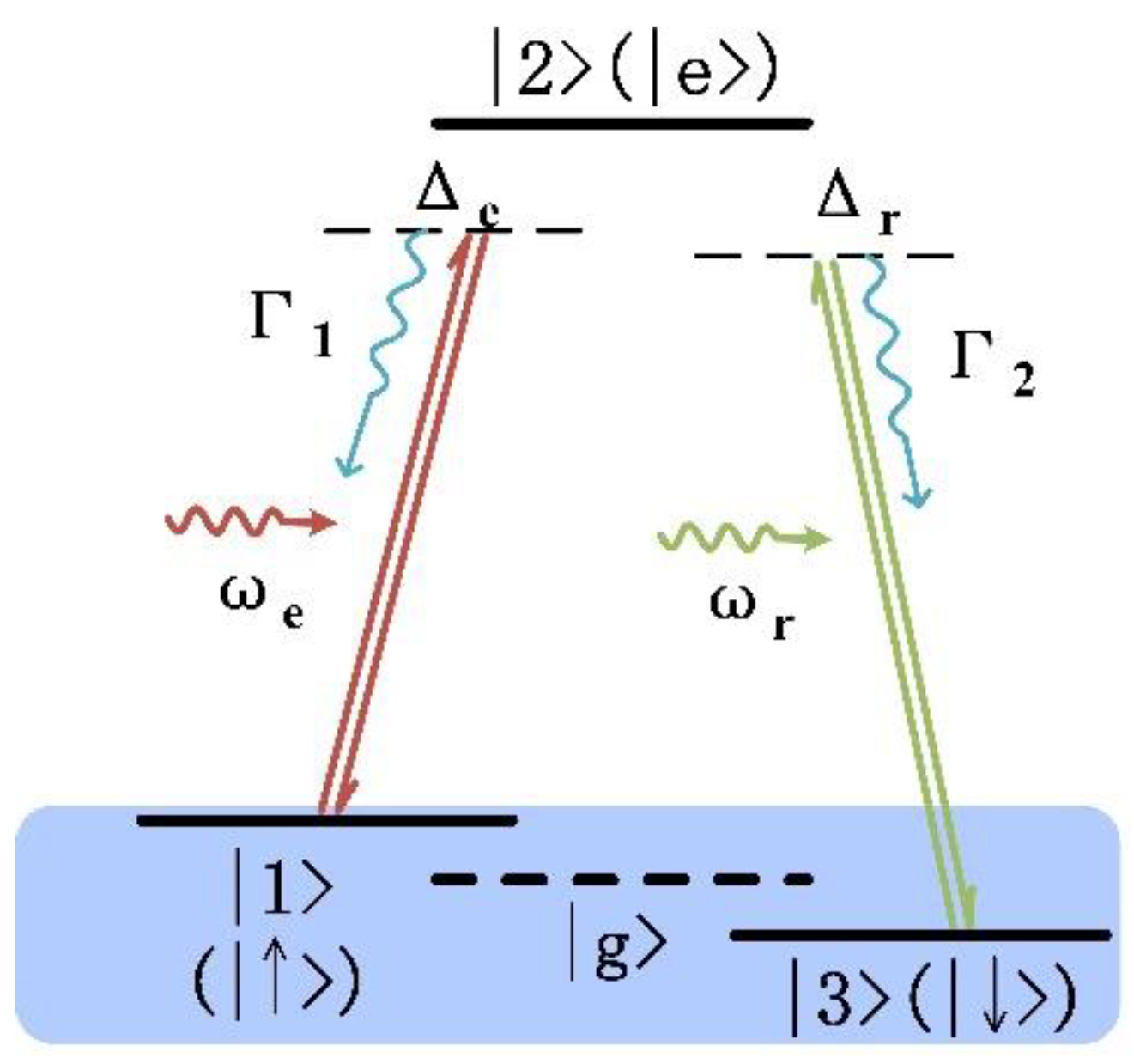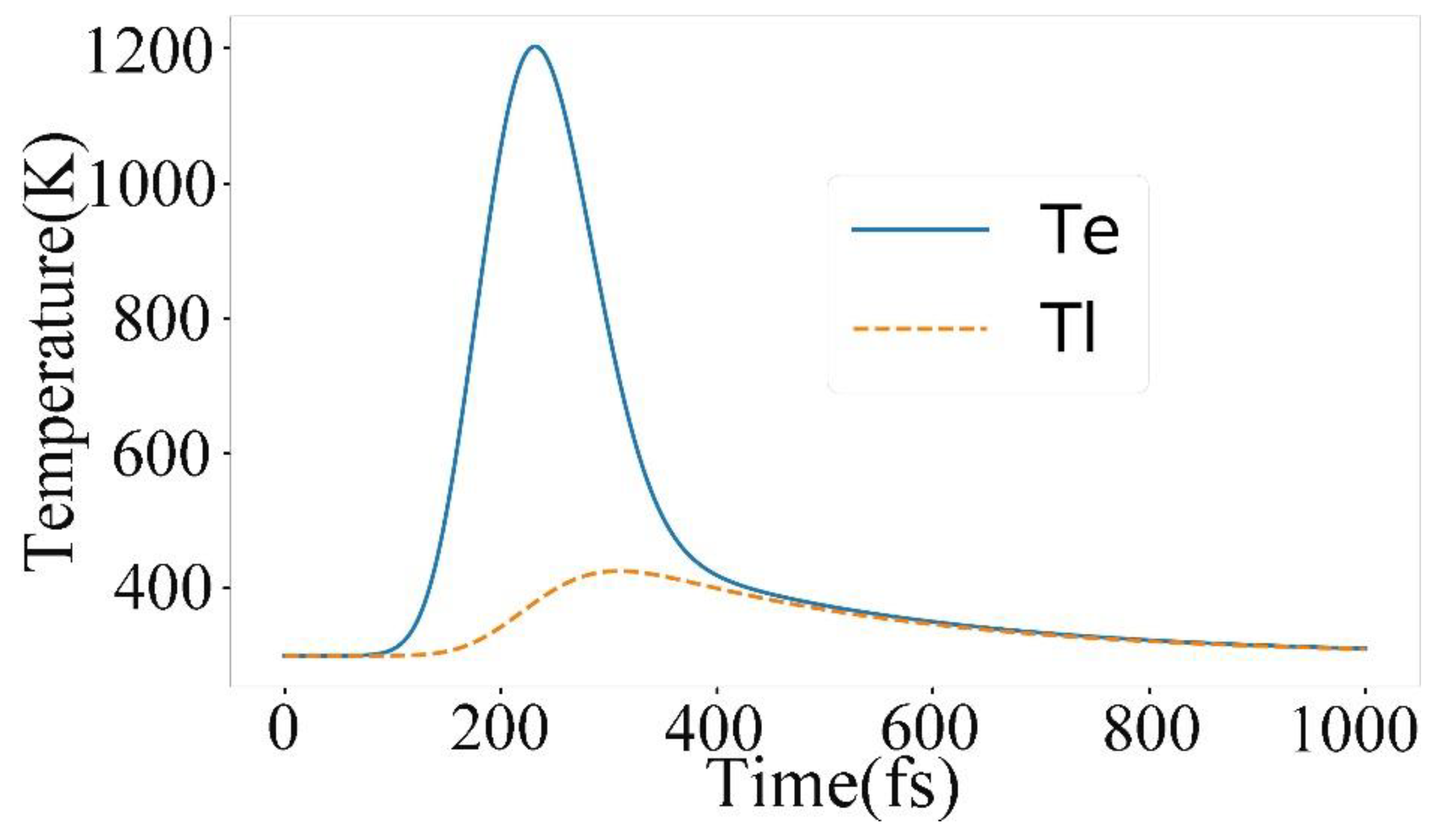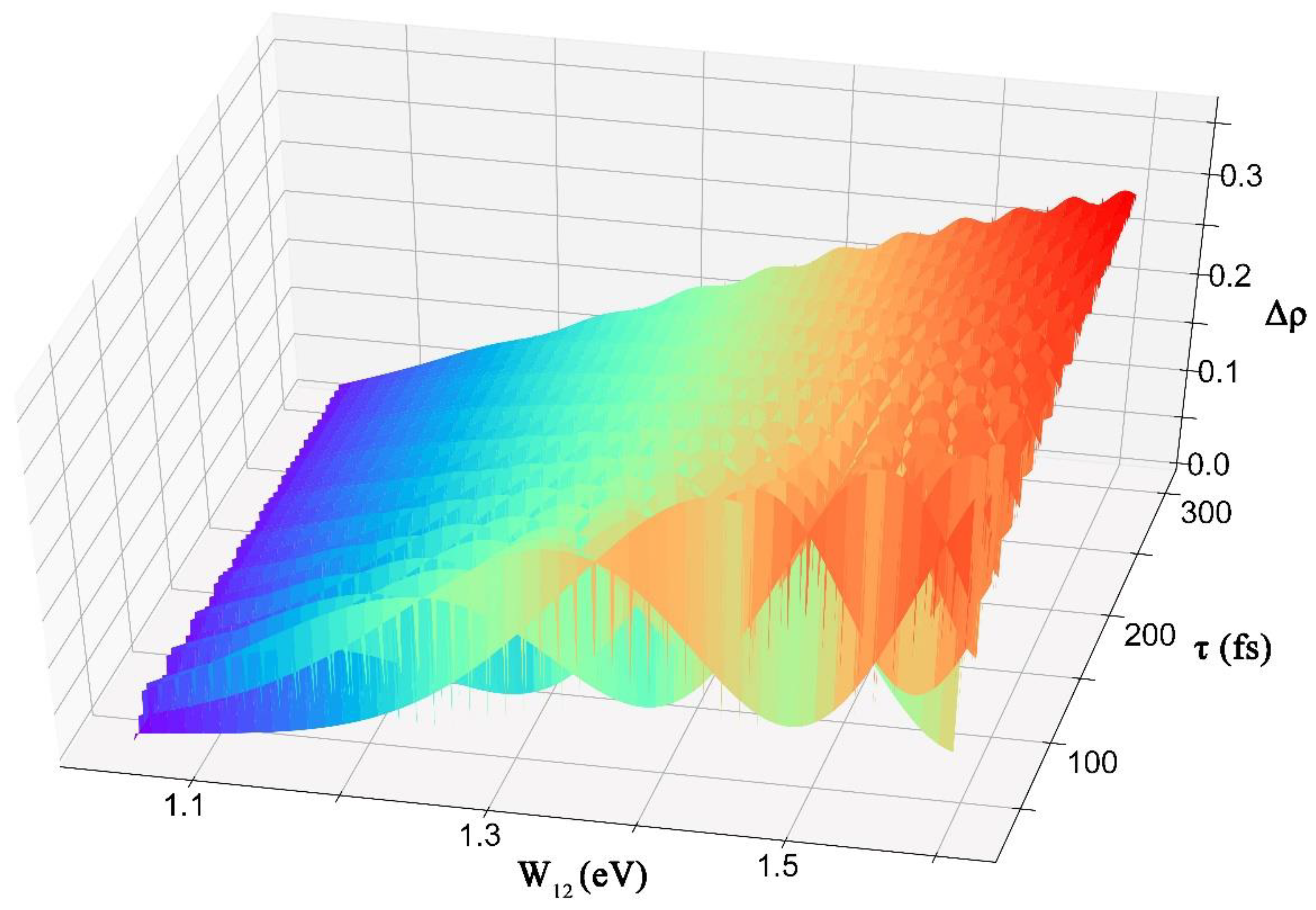Theoretical Investigation of Laser Induced Magnetization Reversal by Spin Orbit Coupling and Stimulated Raman Scattering
Abstract
1. Introduction
2. Interaction of Light and Medium
3. Discussion
3.1. Initial State of Material
3.2. Spin State Transition
4. Conclusions
Author Contributions
Funding
Conflicts of Interest
References
- Kirilyuk, A.; Kimel, A.V.; Rasing, T. Ultrafast optical manipulation of magnetic order. Rew. Mod. Phys. 2010, 82, 2731. [Google Scholar] [CrossRef]
- Stupakiewicz, A.; Szerenos, K.; Afanasiev, D.; Kirilyuk, A.; Kimel, A. Ultrafast nonthermal photo-magnetic recording in a transparent medium. Nature 2017, 542, 71–74. [Google Scholar] [CrossRef] [PubMed]
- Stanciu, C.; Hansteen, F.; Kimel, A.; Kirilyuk, A.; Tsukamoto, A.; Itoh, A.; Rasing, T. All-optical magnetic recording with circularly polarized light. Phys. Rev. Lett. 2007, 99, 047601. [Google Scholar] [CrossRef] [PubMed]
- Vahaplar, K.; Kalashnikova, A.; Kimel, A.; Hinzke, D.; Nowak, U.; Chantrell, R.; Tsukamoto, A.; Itoh, A.; Kirilyuk, A.; Rasing, T. Ultrafast path for optical magnetization reversal via a strongly nonequilibrium state. Phys. Rev. Lett. 2009, 103, 117201. [Google Scholar] [CrossRef] [PubMed]
- Ostler, T.; Barker, J.; Evans, R.; Chantrell, R.; Atxitia, U.; Chubykalo-Fesenko, O.; El Moussaoui, S.; Le Guyader, L.; Mengotti, E.; Heyderman, L. Ultrafast heating as a sufficient stimulus for magnetization reversal in a ferrimagnet. Nat. Commun. 2012, 3, 666. [Google Scholar] [CrossRef] [PubMed]
- Alebrand, S.; Gottwald, M.; Hehn, M.; Steil, D.; Cinchetti, M.; Lacour, D.; Fullerton, E.E.; Aeschlimann, M.; Mangin, S. Light-induced magnetization reversal of high-anisotropy TbCo alloy films. Appl. Phys. A 2012, 101, 162408. [Google Scholar] [CrossRef]
- Lambert, C.-H.; Mangin, S.; Varaprasad, B.C.S.; Takahashi, Y.; Hehn, M.; Cinchetti, M.; Malinowski, G.; Hono, K.; Fainman, Y.; Aeschlimann, M. All-optical control of ferromagnetic thin films and nanostructures. Science 2014, 345, 1337–1340. [Google Scholar] [CrossRef] [PubMed]
- Cornelissen, T.; Córdoba, R.; Koopmans, B. Microscopic model for all optical switching in ferromagnets. Appl. Phys. Lett. 2016, 108, 142405. [Google Scholar] [CrossRef]
- Choi, G.-M.; Schleife, A.; Cahill, D.G. Optical-helicity-driven magnetization dynamics in metallic ferromagnets. Nat. Commun. 2017, 8, 15085. [Google Scholar] [CrossRef]
- Mangin, S.; Gottwald, M.; Lambert, C.; Steil, D.; Uhlíř, V.; Pang, L.; Hehn, M.; Alebrand, S.; Cinchetti, M.; Malinowski, G. Engineered materials for all-optical helicity-dependent magnetic switching. Nat. Mater. 2014, 13, 286–292. [Google Scholar] [CrossRef]
- Pitaevskii, L. Electric forces in a transparent dispersive medium. Sov. Phys. JETP 1961, 12, 1008–1013. [Google Scholar]
- Pershan, P.; Van der Ziel, J.; Malmstrom, L. Theoretical discussion of the inverse Faraday effect, Raman scattering, and related phenomena. Phys. Rev. 1966, 143, 574. [Google Scholar] [CrossRef]
- Van der Ziel, J.; Pershan, P.; Malmstrom, L. Optically-induced magnetization resulting from the inverse Faraday effect. Phys. Rev. Lett. 1965, 15, 190. [Google Scholar] [CrossRef]
- Jiang, L.; Tsai, H.-L. Improved two-temperature model and its application in ultrashort laser heating of metal films. J. Heat Transf. 2005, 127, 1167–1173. [Google Scholar] [CrossRef]
- Kimel, A.V.; Kirilyuk, A.; Rasing, T. Femtosecond opto-magnetism: Ultrafast laser manipulation of magnetic materials. Laser Photon. Rev. 2007, 1, 275–287. [Google Scholar] [CrossRef]
- Huang, T.; Wang, H.; Zou, Y.; Cheng, W.; Xie, C. Explorations on size limit of L10-FePt nanoparticles for practical magnetic storage. AIP Adv. 2016, 6, 115302. [Google Scholar] [CrossRef]
- Huang, T.; Wang, H.; Cheng, W.; Zou, Y.; Xie, C. Critical switching fluence of L10-FePt nanoparticles with practical size to ultrafast all-optical polarization switching. EPL 2017, 118, 67006. [Google Scholar] [CrossRef]
- Steil, D.; Alebrand, S.; Hassdenteufel, A.; Cinchetti, M.; Aeschlimann, M. All-optical magnetization recording by tailoring optical excitation parameters. Phys. Rev. B 2011, 84, 224408. [Google Scholar] [CrossRef]
- Evans, R.F.; Fan, W.J.; Chureemart, P.; Ostler, T.A.; Ellis, M.O.; Chantrell, R.W. Atomistic spin model simulations of magnetic nanomaterials. J. Phys. Condens. Matter 2014, 26, 103202. [Google Scholar] [CrossRef]
- Evans, R.F.; Ostler, T.A.; Chantrell, R.W.; Radu, I.; Rasing, T. Ultrafast thermally induced magnetic switching in synthetic ferrimagnets. Appl. Phys. Lett. 2014, 104, 082410. [Google Scholar] [CrossRef]
- Radu, I.; Vahaplar, K.; Stamm, C.; Kachel, T.; Pontius, N.; Dürr, H.; Ostler, T.; Barker, J.; Evans, R.; Chantrell, R. Transient ferromagnetic-like state mediating ultrafast reversal of antiferromagnetically coupled spins. Nature 2011, 472, 205–208. [Google Scholar] [CrossRef] [PubMed]
- Battiato, M.; Barbalinardo, G.; Oppeneer, P.M. Quantum theory of the inverse Faraday effect. Phys. Rev. B 2014, 89, 014413. [Google Scholar] [CrossRef]
- Atxitia, U.; Chubykalo-Fesenko, O.; Kazantseva, N.; Hinzke, D.; Nowak, U.; Chantrell, R.W. Micromagnetic modeling of laser-induced magnetization dynamics using the Landau-Lifshitz-Bloch equation. Appl. Phys. A 2007, 91, 232507. [Google Scholar] [CrossRef]
- Popova, D. Microscopic description of the inverse Faraday effect at subpicosecond time scales. Available online: https://core.ac.uk/download/pdf/36614088.pdf (accessed on 20 December 2018).
- Popova, D.; Bringer, A.; Blügel, S. Theoretical investigation of the inverse Faraday effect via a stimulated Raman scattering process. Phys. Rev. B 2012, 85, 094419. [Google Scholar] [CrossRef]
- Manchon, A.; Koo, H.C.; Nitta, J.; Frolov, S.; Duine, R. New perspectives for Rashba spin-orbit coupling. Nat. Mater. 2015, 14, 871–882. [Google Scholar] [CrossRef] [PubMed]
- Krupin, O.; Bihlmayer, G.; Starke, K.; Gorovikov, S.; Prieto, J.; Döbrich, K.; Blügel, S.; Kaindl, G. Rashba effect at magnetic metal surfaces. Phys. Rew. B 2005, 71, 201403. [Google Scholar] [CrossRef]
- Miron, I.M.; Gaudin, G.; Auffret, S.; Rodmacq, B.; Schuhl, A.; Pizzini, S.; Vogel, J.; Gambardella, P. Current-driven spin torque induced by the Rashba effect in a ferromagnetic metal layer. Nat. Mater. 2010, 9, 230–234. [Google Scholar] [CrossRef] [PubMed]
- Chen, X.-J. Fundamental mechanism for all-optical helicity-dependent switching of magnetization. Sci. Rep. 2017, 7, 41294. [Google Scholar] [CrossRef] [PubMed]
- Edelstein, V.M. Inverse faraday effect in conducting crystals caused by a broken mirror symmetry. Phys. Rev. Lett. 1998, 80, 5766. [Google Scholar] [CrossRef]
- Qaiumzadeh, A.; Titov, M. Theory of light-induced effective magnetic field in Rashba ferromagnets. Phys. Rew. B 2016, 94, 014425. [Google Scholar] [CrossRef]
- Etienne, T.; Mosconi, E.; De Angelis, F. Dynamical Origin of the Rashba Effect in Organohalide Lead Perovskites: A Key to Suppressed Carrier Recombination in Perovskite Solar Cells? J. Phys. Chem. Lett. 2016, 7, 1638–1645. [Google Scholar] [CrossRef] [PubMed]
- Shore, B.W. Manipulating Quantum Structures Using Laser Pulses; Cambridge University Press: Cambridge, UK, 2011. [Google Scholar]
- Batista, A.A. Rabi oscillations in two-level systems beyond the rotating-wave approximation. arXiv, 2015; arXiv:1507.05124. [Google Scholar]
- Hughes, S. Breakdown of the area theorem: Carrier-wave Rabi flopping of femtosecond optical pulses. Phys. Rev. Lett. 1998, 81, 3363. [Google Scholar] [CrossRef]
- Yang, X.; Wong, C.W. Coupled-mode theory for stimulated Raman scattering in high-Q/Vm silicon photonic band gap defect cavity lasers. Opt. Express 2007, 15, 4763–4780. [Google Scholar] [CrossRef] [PubMed]
- Monfared, Y.E.; Ponomarenko, S.A. Non-Gaussian statistics of extreme events in stimulated Raman scattering: The role of coherent memory and source noise. Phys. Rev. A 2017, 96, 043817. [Google Scholar] [CrossRef]
- Cai, W.; Muraishi, S.; Shi, J.; Nakamura, Y.; Liu, W.; Yu, R. Curie temperatures of CoPt ultrathin continuous films. Appl. Phys. A 2012, 107, 519–523. [Google Scholar] [CrossRef]
- Inaba, N.; Igarashi, S.; Kirino, F.; Fujita, F.; Koike, K.; Kato, H. Magnetic properties of Co/Pt-Pd multilayer thin film media. Phys. Status Solidi C 2007, 4, 4498–4502. [Google Scholar] [CrossRef]




© 2018 by the authors. Licensee MDPI, Basel, Switzerland. This article is an open access article distributed under the terms and conditions of the Creative Commons Attribution (CC BY) license (http://creativecommons.org/licenses/by/4.0/).
Share and Cite
Zou, Y.; Wang, H.; Xiao, Y.; Zeng, Z.; Huang, L.; Wang, K.; Wang, S.; Li, X.; Xie, C. Theoretical Investigation of Laser Induced Magnetization Reversal by Spin Orbit Coupling and Stimulated Raman Scattering. Appl. Sci. 2019, 9, 102. https://doi.org/10.3390/app9010102
Zou Y, Wang H, Xiao Y, Zeng Z, Huang L, Wang K, Wang S, Li X, Xie C. Theoretical Investigation of Laser Induced Magnetization Reversal by Spin Orbit Coupling and Stimulated Raman Scattering. Applied Sciences. 2019; 9(1):102. https://doi.org/10.3390/app9010102
Chicago/Turabian StyleZou, Yuhao, Haiwei Wang, Yao Xiao, Zhihao Zeng, Lanlan Huang, Kai Wang, Sicong Wang, Xiangping Li, and Changsheng Xie. 2019. "Theoretical Investigation of Laser Induced Magnetization Reversal by Spin Orbit Coupling and Stimulated Raman Scattering" Applied Sciences 9, no. 1: 102. https://doi.org/10.3390/app9010102
APA StyleZou, Y., Wang, H., Xiao, Y., Zeng, Z., Huang, L., Wang, K., Wang, S., Li, X., & Xie, C. (2019). Theoretical Investigation of Laser Induced Magnetization Reversal by Spin Orbit Coupling and Stimulated Raman Scattering. Applied Sciences, 9(1), 102. https://doi.org/10.3390/app9010102





